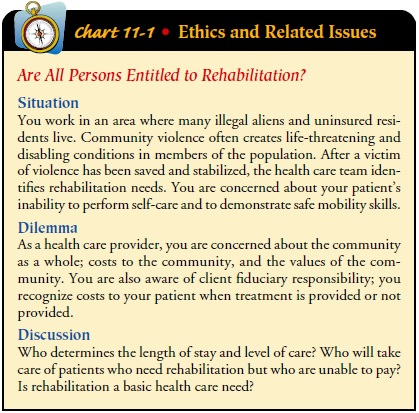Chapter: Medical Surgical Nursing: Principles and Practices of Rehabilitation
Principles and Practices of Rehabilitation
Principles and Practices of Rehabilitation
Rehabilitation is a dynamic, health-oriented process that assists an ill
person or a person with disability (restriction in performance or function in
everyday activities) to achieve the greatest possible level of physical,
mental, spiritual, social, and economic functioning. The rehabilitation process
helps the pa-tient achieve an acceptable quality of life with dignity, self-respect,
and independence and is designed for people with physical, men-tal, or
emotional disabilities. During rehabilitation—sometimes called habilitation—the
patient adjusts to the disability by learn-ing how to use resources and to
focus on existing abilities. In ha-bilitation,
abilities, not disabilities, are emphasized.
Rehabilitation is an
integral part of nursing because every major illness or injury carries the
threat of disability or impair-ment,
which involves a loss of function or an abnormality. Theprinciples of
rehabilitation are basic to the care of all patients, and rehabilitation
efforts should begin during the initial contact with a patient. The goal of
rehabilitation is to restore the patient’s abil-ity to function independently
or at a preillness or preinjury level of functioning as quickly as possible. If
this is not possible, the aims of rehabilitation are maximal independence and a
quality of life acceptable to the patient. Realistic goals based on individual
patient assessment are established with the patient to guide the rehabilitation
program.
Rehabilitation services are required by more people than ever before
because of advances in technology that save or prolong the lives of seriously
ill, injured, and disabled patients. Increasing numbers of patients who are
recovering from serious illnesses or injuries are returning to their homes and
communities with on-going needs. Every patient, regardless of age, gender,
ethnic group, socioeconomic status, or diagnosis, has a right to rehabilitation
services (Chart 11-1).

Approximately 1 in 5 Americans has some form of disability, and 1 in 10
has a severe disability (U.S. Census Bureau, 1997). A person is considered to
have a disability, such as a restriction in performance or function in everyday
activities, if he or she has dif-ficulty talking, hearing, seeing, walking,
climbing stairs, lifting or carrying objects, performing activities of daily
living, doing school work, or working at a job. A severe disability is present
if a person is unable to perform one or more activities, uses an assistive
device for mobility, or needs help from another person to accomplish basic
activities. Individuals are also considered severely disabled if they receive
federal benefits based on an inability to work.
Approximately 54 million Americans are affected by some form of disability, and this number is expected to increase in the com-ing decades due to the aging of the population. More than half of persons with disability are women, and females with disability out-number males in all age groups except for those 15 to 24 years old (Jans & Stoddard, 1999). One-third of women 75 years of age and older need personal assistance. Currently, more than 10 million people need personal assistance with one or more activities ofdaily living (ADLs), which include bathing, dressing, feeding,and toileting, or instrumental activities of daily living (IADLs), which include grocery shopping, meal preparation, housekeep-ing, transportation, and managing finances. About 5 million per-sons use a cane, more than 2 million use a wheelchair, and at least 1 million use crutches or a walker. Use of these devices and other types of assistive technology has increased dramatically due to the aging of the population, technological advances, public pol-icy initiatives, and changes in the delivery and financing of health care (U.S. Census Bureau, 1997).
Related Topics